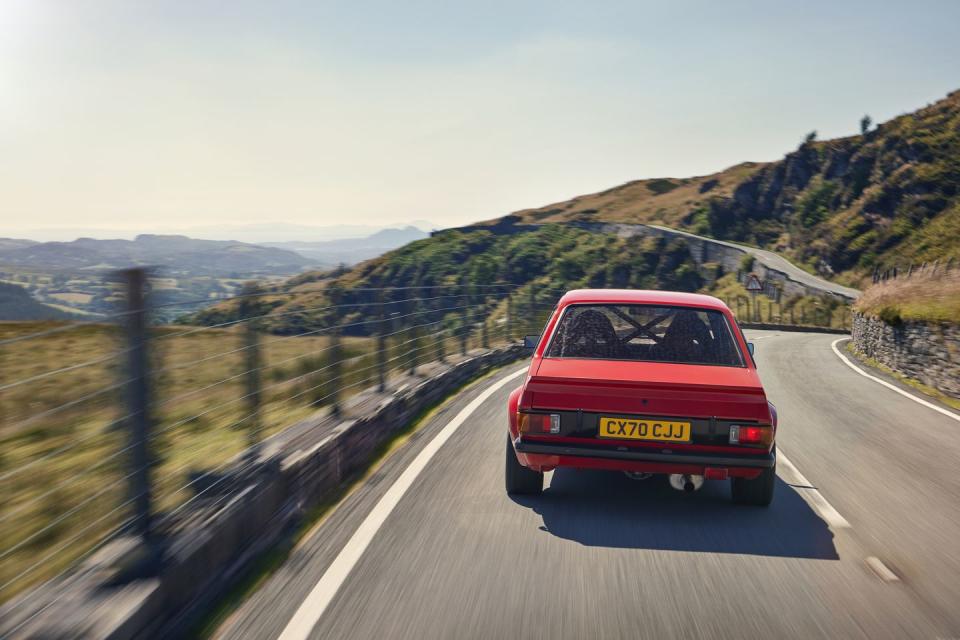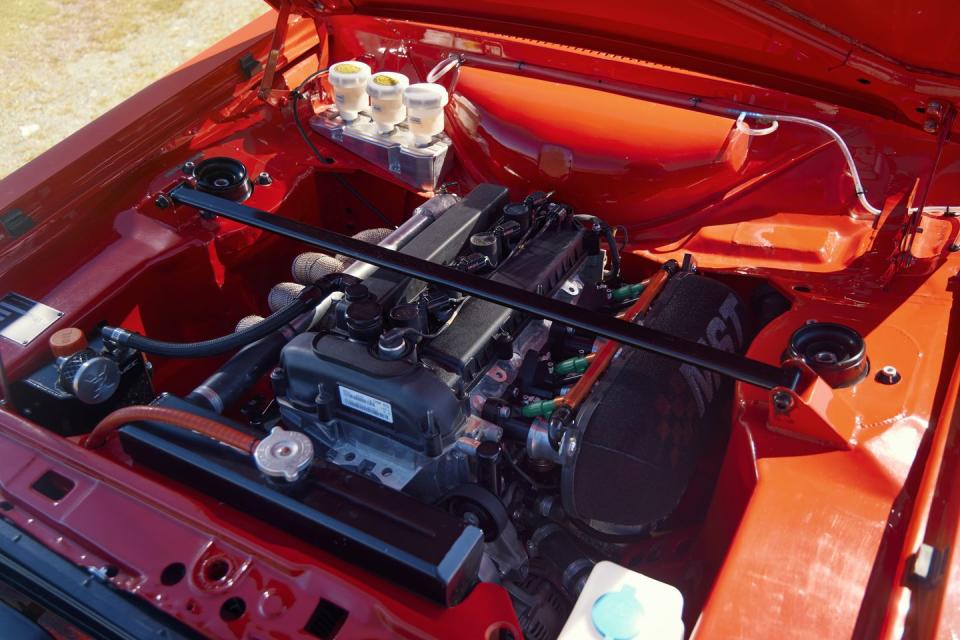Don't Call the MST Mk2 an Escort


Of all the cultural disconnects between Brits and Americans, perhaps none is more fundamental than the Ford Escort.
To most Americans, Escort calls to mind a turquoise-painted sad sack of an economy car from the Eighties and Nineties that, even when done up in GT guise, was as spicy as a bowl of Cream of Wheat.
But to Brits, and the more worldly American enthusiasts, the first two generations of FordEscort, the rear-drive versions made between 1967 and 1980, formed a locus of so many sliding, gravel-flinging rally-car dreams.
This story originally appeared in Volume 7 of Road & Track.
SIGN UP FOR THE TRACK CLUB BY R&T FOR MORE EXCLUSIVE STORIES
The list of iconic street-legal racing cars is replete with the beautiful and exotic, such as the Ferrari 250 GTO and the Aston Martin DB4 GT. Yet this humble European-market Ford should be on the list, too.
The regular Escort was utility-grade transport, produced in millions to build standards similar to what Ford’s U.S. buyers were experiencing at the time. But it was also the basis for a succession of rally stars, hugely successful in period and with a popularity that—coupled with the base Escort’s ubiquity—means many are still competing today. Which is why, more than 40 years after Ford made the last Mk2 Escort, a British motorsport parts supplier by the name MST has put it back into limited production.

This isn’t a restoration or a restomod. According to the U.K.’s bureaucracy, this is an all-new car, a blue-collar equivalent to the grander “continuation” models being produced by Jaguar, Bentley, and Aston Martin.
Getting to this point was what MST boss Carwyn Ellis describes as a “connect-the-dots decision.” A farmer’s son and amateur rally competitor from the Llŷn Peninsula, where Welsh is most people’s first language, Ellis founded his company to supply parts to fellow racers. Realizing he had practically every Escort part in his warehouse, Ellis decided to combine them into fresh cars. The plan is to offer rally and road-spec versions of both the Mk1 and Mk2 (they sit on an identical floorpan).
The company’s test car is this mid-spec Mk2. As a prototype, it isn’t built to the standard MST promises for customer cars. Up close, the paint finish isn’t perfect, and some of the panel gaps aren’t as tight as Ellis would like. But it still looks like what it is: a brand-new Escort. Well, nearly. As the company doesn’t own rights to the name, which Ford still uses in the Chinese market, this is officially the MST Mk2.

This one has been given almost all the modifications commonly applied to rallying Escorts since the Seventies. It sits on widened fenders, described by rally fans as the Group 4 look, after the FIA technical regulations that were abolished in 1983. At the back it has an upgraded live axle held in place by four substantial trailing longitudinal links and a Watt’s linkage rather than the pair of leaf springs Ford used for road cars. Behind the dinky (but period-correct) 13-inch Minilite wheels are AP Racing brakes with adjustable front-rear bias. A motorsport-grade aluminum fuel tank fills most of the trunk, aside from a cutout to accommodate two spare wheels for rougher dirt rallies.
The cabin features a roll cage, bucket seats, and a microfiber steering wheel with one of those“straight ahead” bands to help keep track of where the front wheels are pointing. A new dashboard features a no-nonsense rev counter that condenses everything below 4000 rpm into one segment.
Even more has changed mechanically. Early Mk2 rally cars ran a Cosworth-developed BDA twin-cam four-cylinder, but those are both seriously expensive and unable to pass modern emissions standards. MST’s tester uses a U.S.-spec 2.5-liter four-cylinder Ford Duratec, with individual throttle bodies and a custom ECU to make 200 hp. The engine sends torque through a six-speed manual gearbox from a Mazda Miata. The lowly power output is offset by the fact the trimless Escort weighs just over 2100 pounds.

The engine is loud and raucous. It doesn’t have the wail of a BDA, but it sounds suitably muscular when being worked hard and clearly enjoys the exercise. The prototype had a limiter set to 7200 rpm, but Ellis says the engine can go safely to 8000 rpm after an ECU tweak. The transmission ratios are stacked closely, and a quick-shift gear selector has a heavy action but, once mastered, makes it easy to switch between them. Performance is brisk rather than 2021 fast: MST reckons the Mk2 would be capable of a six-second 0–60 mph time and a top speed of around 130 mph.
Buyers can choose their suspension based on how they intend to use the car. This test car carries asphalt settings, making it too low and stiff for the gravel-flinging forest action that made its rallying predecessors famous. MST claims it would take less than an hour to swap it to dirt spec. On road the springs are soft enough to result in noticeable roll under hard cornering, but motorsport-grade Bilstein dampers keep the car’s modest mass under tight control.

Against expectations born from YouTube rally videos, the Mk2 isn’t a sideways monster, certainly not on dry pavement. Adhesion from the small-diameter Kumho tires is huge, and although the engine has the torque to turn the handling balance amusingly back-endy in lower gears, at higher speeds there is much more grip than potential for slip. MST has fitted 12-volt assistance to the steer-ing; this fades out above parking-lot speeds. The front suspension geometry has lots of toe-out, making the car eager to turn into slower corners, but requiring lots of small steering inputs to keep on course when cruising. The brakes bite hard, but competition pads make them noisy under gentle use. This isn’t a car for gentle use.
Without carpet or noise insulation, the MST Mk2 is loud and boomy. Hitting a reflective road stud sounds like a gunshot. Despite the modest power output, lots of heat reaches the interior through the firewall and transmission tunnel. The feeble ventilation fan is Seventies terrible. Staying cool means rolling down the windows, although the prototype’s cranks hit the roll-cage door bars. MST is working on an electric conversion.
Ellis says this car is in Stage 2 tune. Buyers will be able to select a more road-biased Stage 1 or a more competition-focused Stage 3. They’ll also be able to specify an engine from specialist builder Millington making up to 370 hp and working best with a modern sequential gearbox. Being hand-built to order means that none are cheap, as even the least expensive car will be £75,000—just over $100,000 at current exchange rates. Still, the company has already sold out its first year of production.
Ellis says it is possible to order a car with an original shell, likely sourced from Scandinavia. These will require much more structural work and won’t be any cheaper, but will officially be old enough to come to the States under the 25-year exemption.
However you look at it, this is a high-class Escort.

2022 MST Mk2
PRICE:
$115,000 (as tested)
ENGINE:
2.5-liter I-4
OUTPUT:
200 hp @ 7000 rpm
200 lb-ft @ 4500 rpm
TRANSMISSION:
6-speed manual
CURB WEIGHT:
2116 lb
You Might Also Like

 Yahoo Movies
Yahoo Movies 
